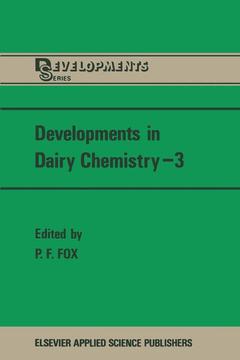Description
Developments in Dairy Chemistry—3, Softcover reprint of the original 1st ed. 1985
Lactose and Minor Constituents
Coordinator: Fox P. F.
Language: English
Publication date: 10-2011
406 p. · 15.2x22.9 cm · Paperback
406 p. · 15.2x22.9 cm · Paperback
Description
/li>Contents
/li>
This volume is the third in the series on the chemistry and physical chemistry of milk constituents. Volumes 1 and 2 dealt with the com mercially more important constituents, proteins and lipids, respectively. Although the constituents covered in this volume are of less direct commercial importance than the former two, they are nevertheless of major significance in the chemical, physical, technological, nutritional and physiological properties of milk. Lactose, the principal component of the milks of most species, is a rather unique sugar in many respects---it has been referred to as one of Nature's paradoxes. It is also the principal component in concentrated and dehydrated dairy products, many of the properties of which reflect those of lactose. The chemistry and principal properties of lactose have been thoroughly researched over the years and relatively little new information is available on these aspects; this new knowledge, as well as some of the older literature, is reviewed in Chapter 1.
1. Lactose: Chemical and Physicochemical Properties.- 2. Developments in the Chemistry and Chemical Modification of Lactose.- 3. Modification of Lactose and Lactose-containing Dairy Products with ?-Galactosidase.- 4. Nutritional Significance of Lactose: I. Nutritional Aspects of Lactose Digestion.- 5. Nutritional Significance of Lactose: II. Metabolism and Toxicity of Galactose.- 6. The Milk Salts: Their Secretion, Concentrations and Physical Chemistry.- 7. Nutritional Aspects of Minerals in Bovine and Human Milks.- 8. Flavour of Milk and Milk Products.- 9. Indigenous Milk Enzymes.- 10. The Biological Significance of the Non-immunoglobulin Protective Proteins in Milk: Lysozyme, Lactoferrin, Lactoperoxidase.- 11. Vitamins in Bovine and Human Milks.
© 2024 LAVOISIER S.A.S.
These books may interest you

Dairy Chemistry and Biochemistry 68.56 €

Dairy Chemistry and Biochemistry 94.94 €



